Then and Now: The World's Ancient Landmarks, in Pictures
Ancient wonders through time
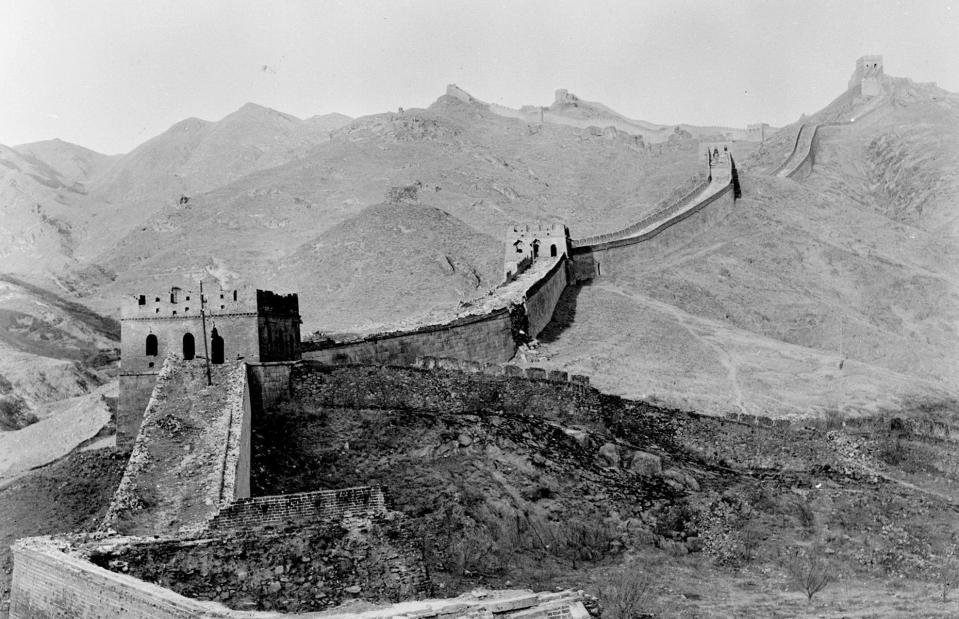
Three Lions/Getty Images
We’re used to seeing modern photos of the world’s ancient wonders, from the towering Giza Pyramids to the ruins of Pompeii and the Great Wall of China. But what did they look like 50, or even 100 years ago? We delve into the archives to bring you vintage snaps of the planet’s most famous ancient landmarks and reveal some historic secrets along the way.
Great Sphinx of Giza, Egypt
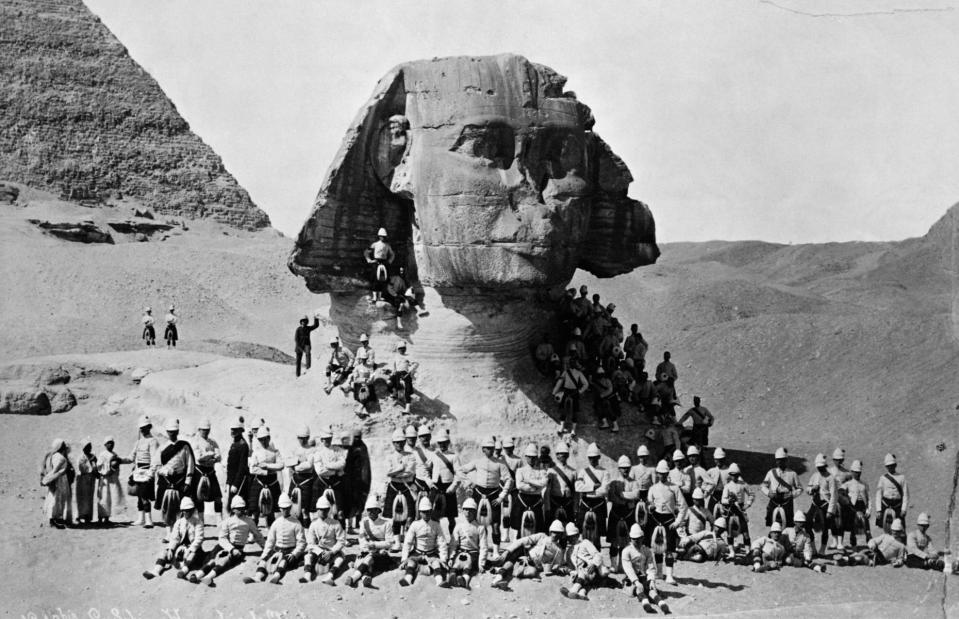
Hulton-Deutsch Collection/CORBIS/Corbis via Getty Images
Rising from the Giza Plateau, Egypt's Sphinx sculpture is one of the world's most jaw-dropping landmarks. It's enormous, at about 240-feet (73m) long and 66-feet (20m) high, and it's thought to have been built under King Khafre, who ruled some 4,500 years ago. The legendary monument was actually buried right up to the shoulders for centuries, and it wasn't entirely excavated until the 1930s. It's still partially entombed in sand in this 1882 photo, which shows British troops swarming the monument after the Battle of Tel-El-Kebir.
Great Sphinx of Giza, Egypt
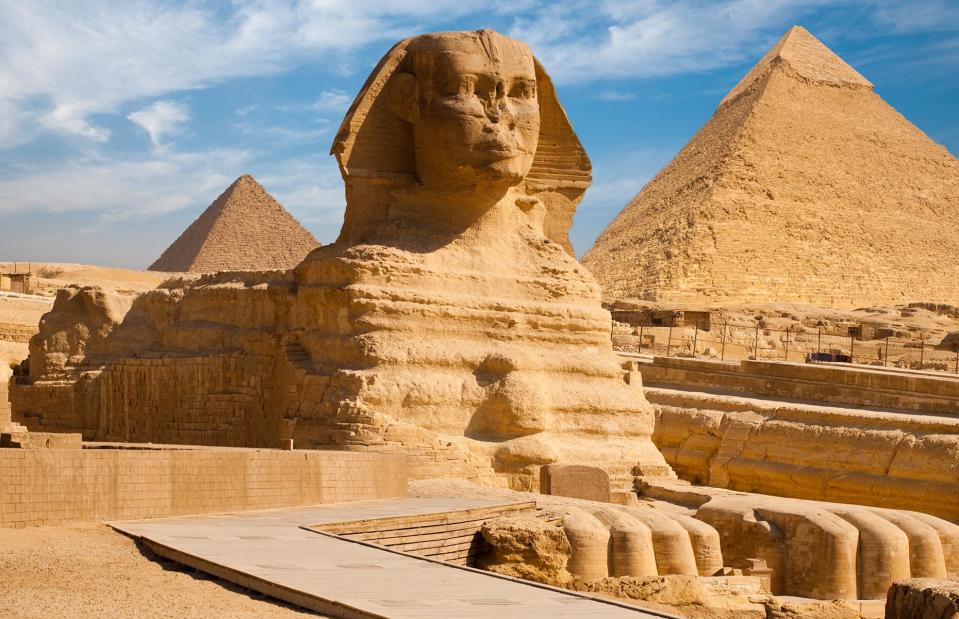
Daily Travel Photos/Shutterstock
This more modern snap shows the great landmark freed from its sandy confines, with the Giza pyramids soaring in the background. In more recent years, archaeologists have continued digging (both literally and figuratively) and have revealed fascinating snippets about the workers who likely built it. The discovery of a huge store of cattle bones, for example, suggests that a thousands-strong work force feasted on high-quality meats as they toiled away.
Pyramids of Giza, Egypt
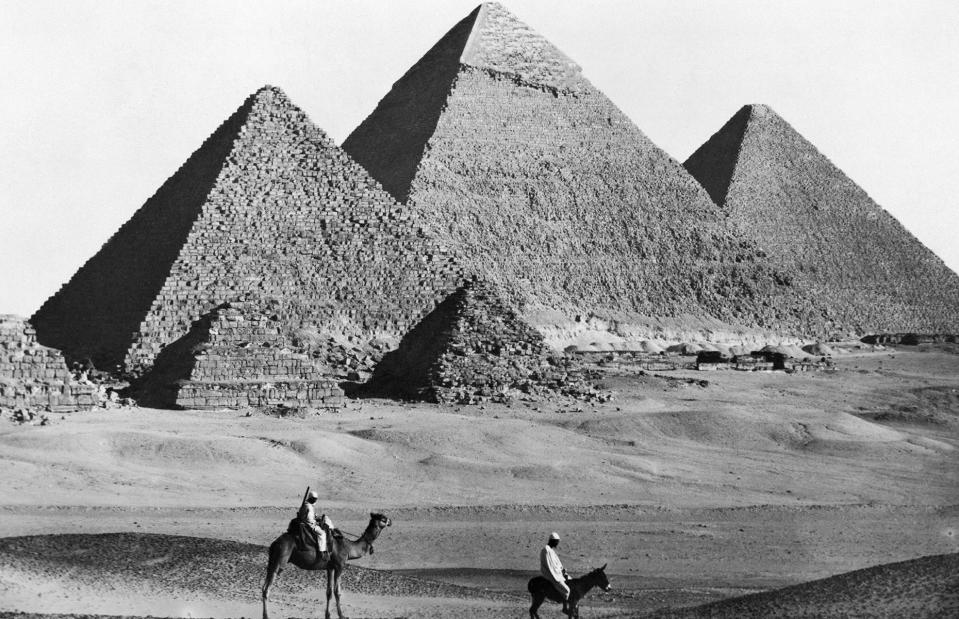
Bettman/Getty Images
If this photo wasn't black and white, you'd probably think it was a modern-day shot. That's because the colossal Pyramids of Giza – built around 4,500 years ago – have changed little over the past centuries. They didn't always look like this, though. According to Smithsonian, the limestone was originally worked and smoothed with a sandstone brick, leaving a polished white finish that glinted in the sun. This picture captures the much more familiar, weather-beaten structures sometime in the late 1800s or early 1900s.
Pyramids of Giza, Egypt
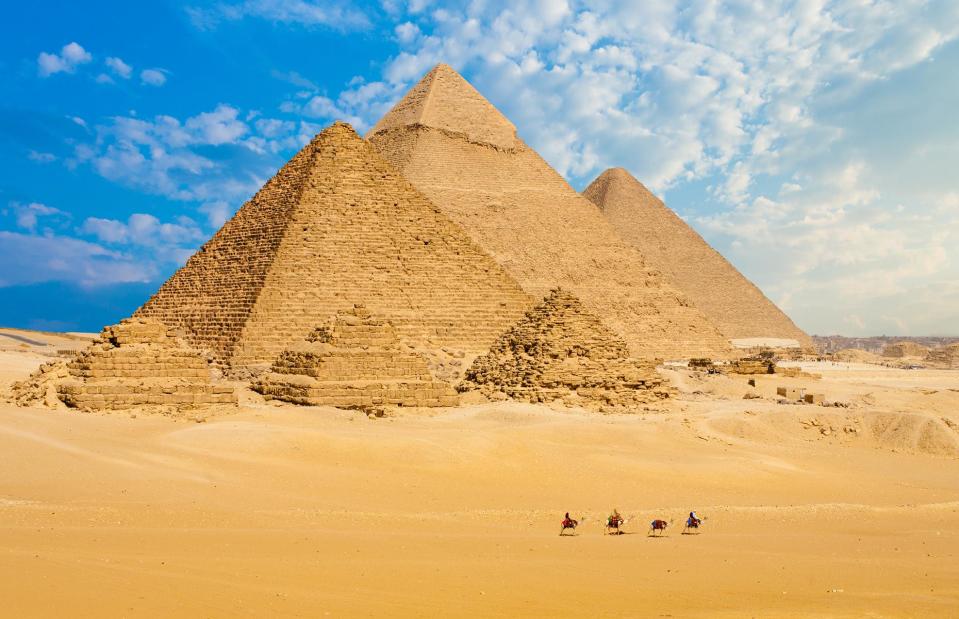
Daily Travel Photos/Shutterstock
Today the pyramids look much the same as they did around a century ago, right down to the folks riding camels in the foreground. But our understanding of these monuments is constantly changing. For example, archaeologists have discovered curious contraptions that go some way to explaining how the giant landmarks were built. More findings also suggest that the pyramids were held together with a concoction of limestone chippings and mortar, much like modern concrete.
Love this? Follow our Facebook page for more travel inspiration
Treasury, Petra, Jordan
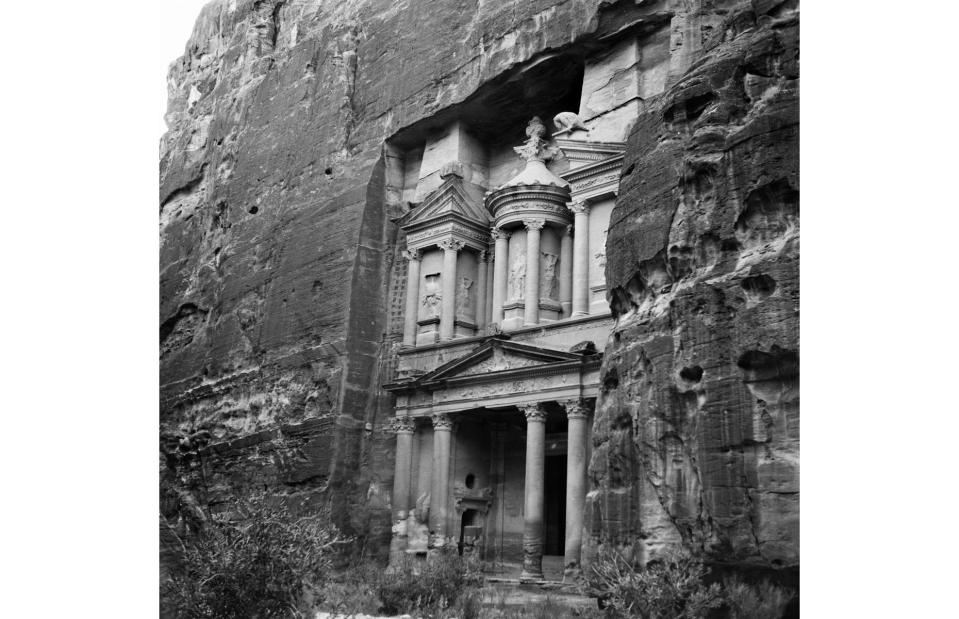
English Heritage/Getty Images
Hewn from mighty bluffs of red sandstone, the Treasury (or Al-Khazneh) is the greatest wonder left behind in the ancient city of Petra. The city is thought to have thrived from around 400 BC and experts believe that the elaborate Treasury served as a royal mausoleum. Europeans tracked down the incredible ruins in the early 1800s and the site gradually established itself as a tourist destination. This close-up shot taken circa 1900 shows off the Treasury's stunning columns and carvings.
Treasury, Petra, Jordan
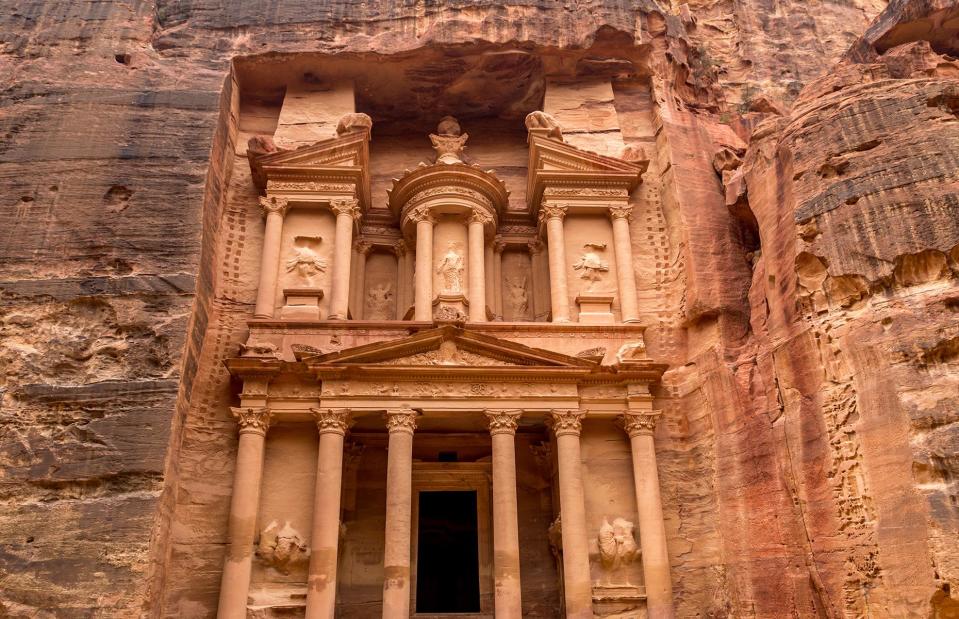
Jene Smu/Shutterstock
The gorgeous salmon and burnt-orange colors of the Treasury are on full display in this modern-day shot, but apart from that the two snaps differ very little. Nevertheless, the ancient structure, which typically receives around one million visitors per year, has felt the impacts of tourism. According to studies, the precious sandstone here, including that of the Treasury's façade, is wearing away due to tourist activities including walking and sitting. The site has been protected under UNESCO since 1985.
Discover these incredible tourist attractions that no longer exist
Stonehenge, Somerset, England, UK
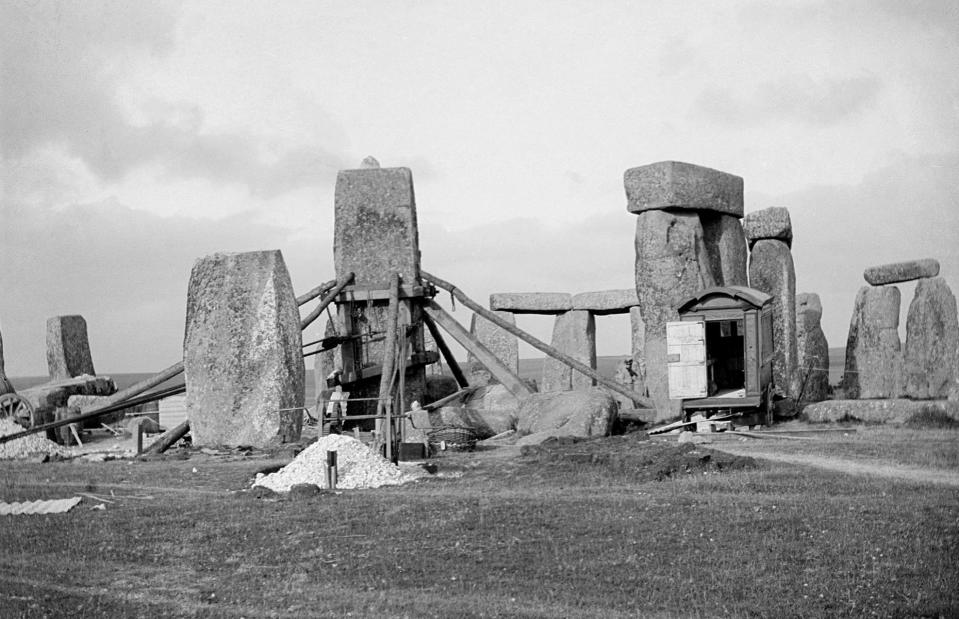
English Heritage/Heritage Images/Getty Images
This mammoth stone circle has been baffling experts for time immemorial. The impossibly perched henge is thought to date back some 4,500 years, yet its exact purpose and usage still remains a mystery. Its stones are carefully arranged to line up with the movements of the sun, so it could have served as some kind of Neolithic calendar or, more likely, a place of worship and/or a burial site. Over the last century, the site has been carefully restored and studied further. This photo from 1901 captures a landmark dig and restoration project overseen by renowned British engineer William Gowland.
Stonehenge, Somerset, England, UK
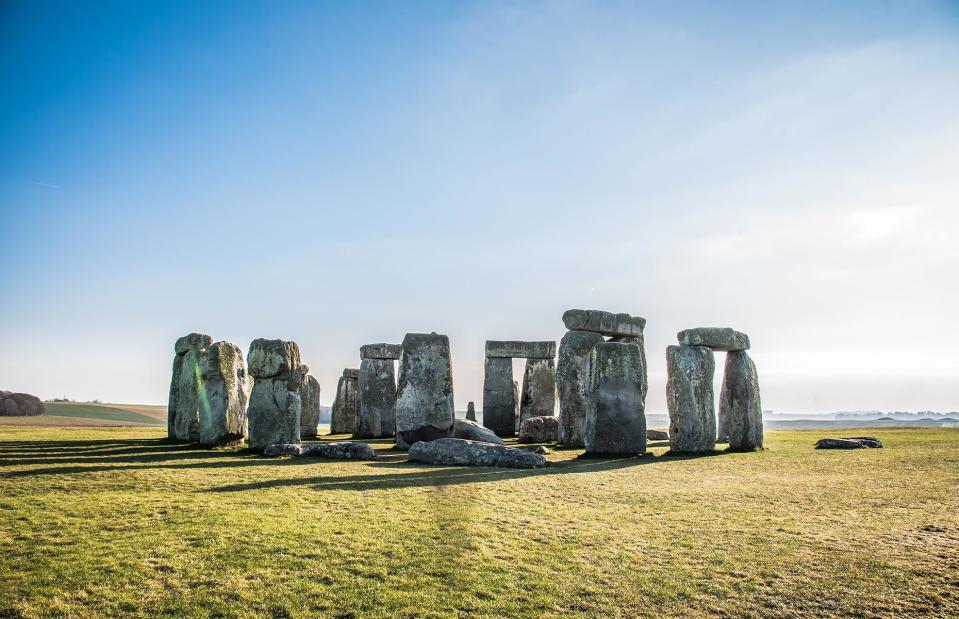
Chatupat/Shutterstock
This image shows Stonehenge more than 100 years later. Gowland's wooden frames and equipment are long gone, but experts are still trying to understand the fascinating monument. The most recent excavations have turned up relics including deer antlers, pottery and burial sites. New evidence has also linked Stonehenge to a site called Waun Mawn in Pembrokeshire and archaeologists now believe that the monument was erected in Wales, before being transported to its current site on the Salisbury Plain.
Check out more mysterious stone circles still baffling experts
Easter Island, Chile
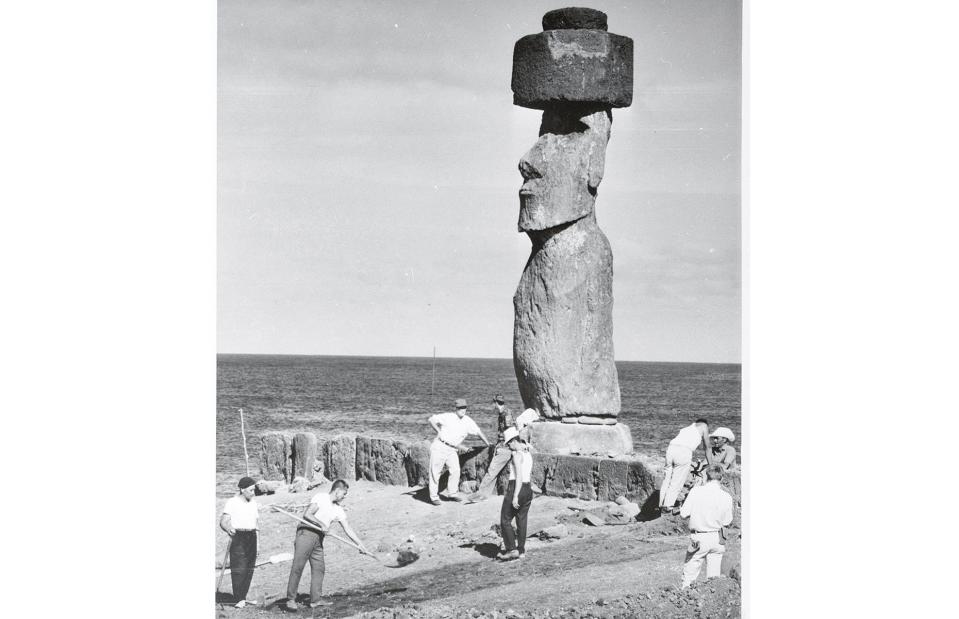
Bettmann/Getty Images
The carved human figures, or moai, scattered across Chile's Easter Island really have to be seen to be believed. The tallest among them soars to well over 30 feet (9m) and although it's not known exactly when these colossal busts were built, there's no doubt they've watched over the island for centuries. Extensive restoration projects were carried out in the mid-20th century – here archaeologists work on a towering moai circa 1969.
Easter Island, Chile
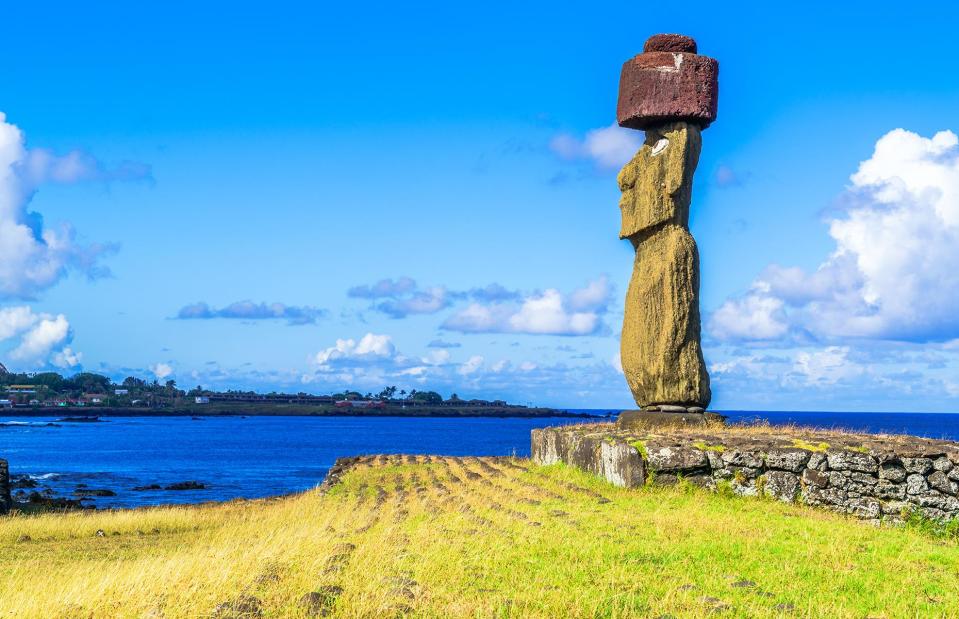
takepicsforfun/Shutterstock
Pictured here about half a century later is Ahu Ko Te Riku, a moai in the Tahai complex, looking over the South Pacific Ocean with its striking restored coral eyes. Modern-day archaeologists are still trying to work out the reason why these brooding statues were erected. The most recent studies have linked their locations to the presence of fresh water sources.
Arch of Constantine, Rome, Italy
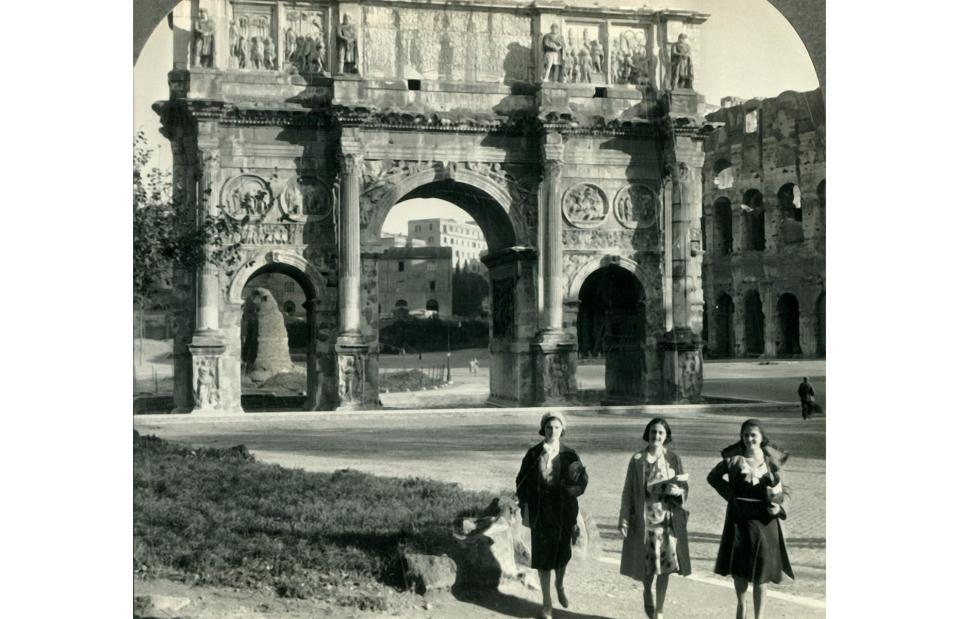
The Print Collector/Heritage Images/Getty Images
You can barely turn a corner in Rome without coming face to face with some glorious ancient wonder. Among them is the Arch of Constantine, which enjoys pride of place right next to the fabled Colosseum. The triumphal arch is decorated with elaborate reliefs and friezes, and was built in AD 315 to celebrate Constantine's victory over Maxentius at the Battle of Milvian Bridge. It's long been earmarked by tourists as a photo spot: this shot shows a trio of smiling visitors posing before the monument circa 1930.
Arch of Constantine, Rome, Italy
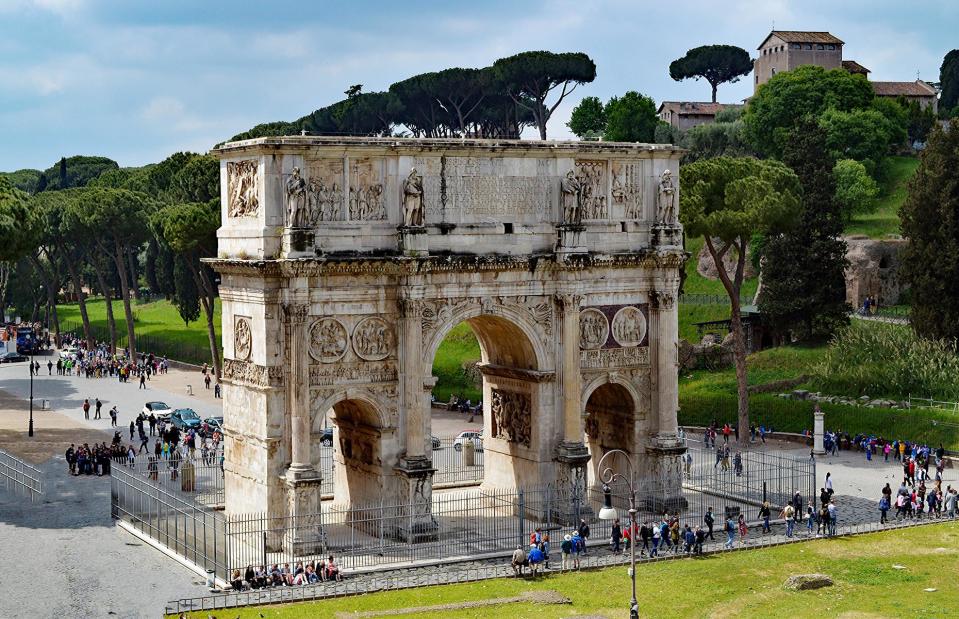
Brian Bourbeau/Shutterstock
The imposing arch remains remarkably preserved today and it's still a magnet for camera-wielding tourists. In fact, since the 1930s shot, a fence has been installed around the popular landmark to protect it from damage and wear and tear. Otherwise, the Roman relic looks much as it did nigh on a century ago.
Roman Baths, Bath, England, UK
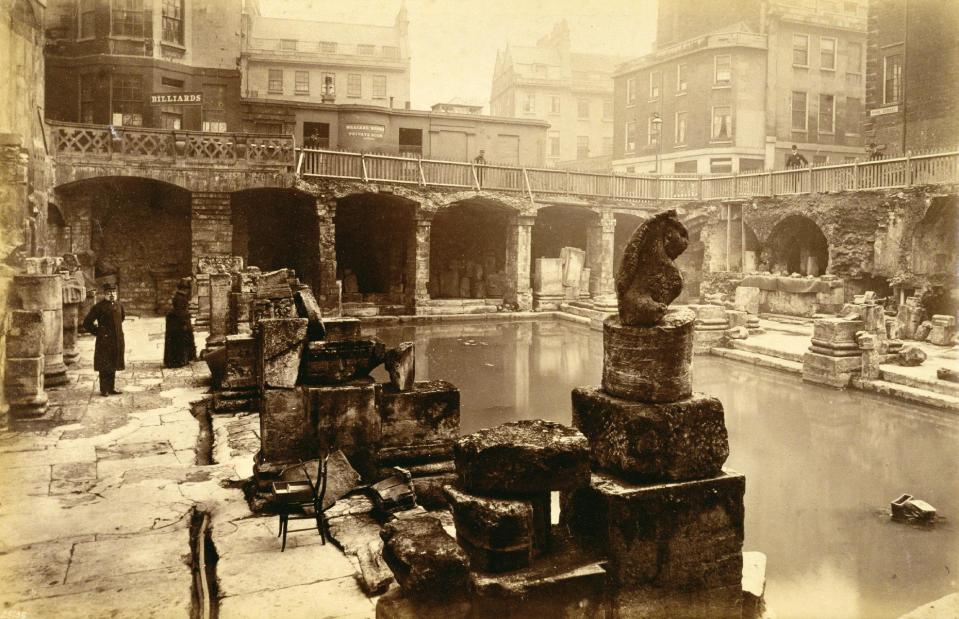
Historica Graphica Collection/Heritage Images/Getty Images
The Romans revered the hot springs that bubble in the ancient city of Bath. Convinced of the water's healing properties, they built an extravagant bathhouse and a temple devoted to goddess Sulis Minerva. But after Roman rule ended in Britain, the baths fell into disuse and disrepair. The site was rediscovered in the 1880s and large parts of the Great Bath were uncovered and eventually opened to the public in 1897. Tourists look across the ruins of the Great Bath in this photo taken in the late 19th century.
Roman Baths, Bath, England, UK
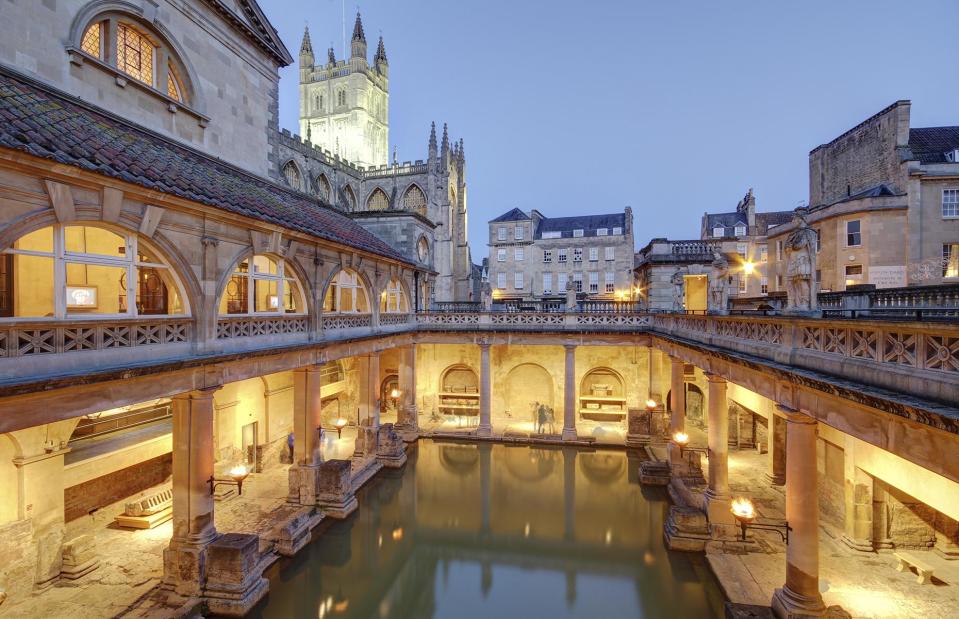
Ollie Taylor/Shutterstock
Pictured here more than a century later, the Great Bath is glittering once again. It's no longer possible to bathe in the waters, but modern visitors to the site can still immerse themselves in ancient Roman history. Typically tourists wander around the Great Bath and drink in the Temple Courtyard, where the Romans would have worshiped goddess Sulis Minerva. The Thermae Bath Spa, which is fed by those famous hot springs, is right on the doorstep too.
Discover more of the world's most amazing Roman ruins
Pula Arena, Pula, Croatia
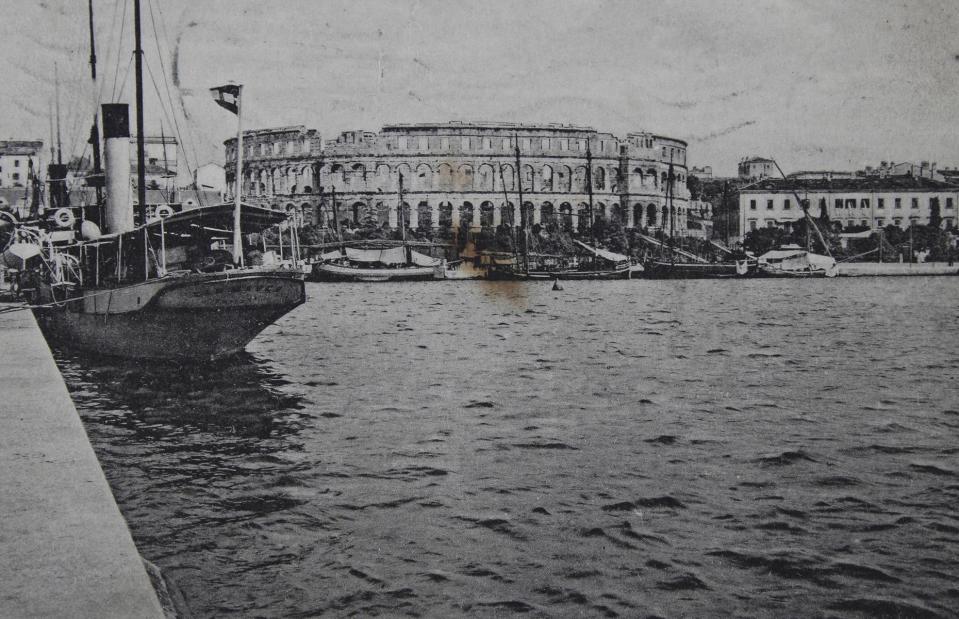
Austrian Archives/Imagno/Getty Images
Give this vintage photo a fleeting glance and you'd be forgiven for thinking it captures Rome's Colosseum. But it actually shows the much less famous (though arguably equally impressive) Pula Arena in Croatia. This enormous Roman amphitheater, first built under Emperor Augustus (27 BC to AD 14), is wonderfully preserved, still boasting its three levels and four side towers. It's snapped here circa 1910, viewed from across the boat-dotted harbor.
Pula Arena, Pula, Croatia
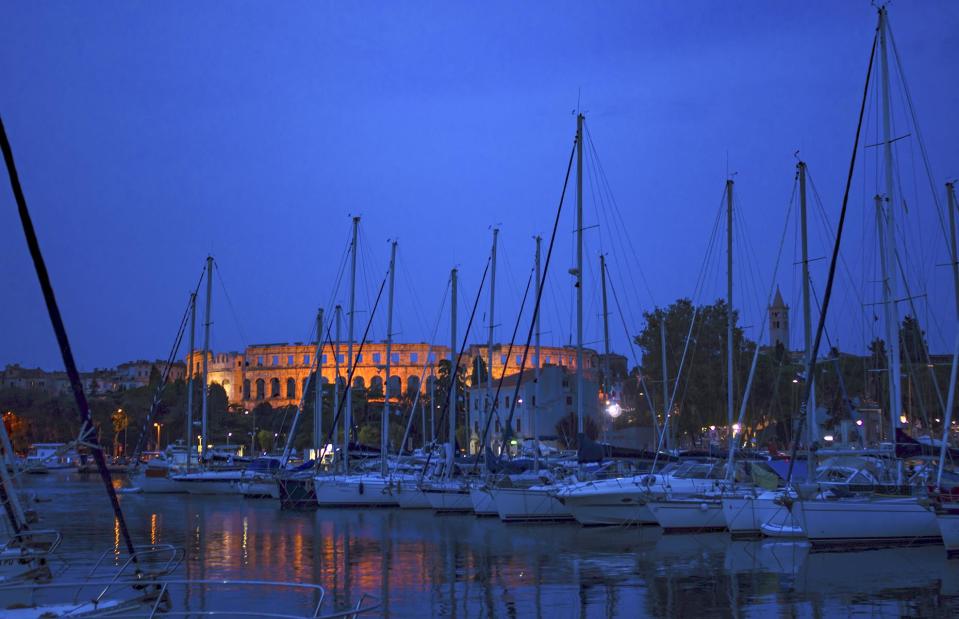
Dan Rata/Shutterstock
In this present-day night shot, Pula Arena is juxtaposed with its more modern surroundings. The harbor is crammed with sleek sail boats and lights glitter on the water at dusk. Today history buffs can explore the amphitheater and it also typically hosts concerts, dance shows and festivals in place of bloody gladiatorial battles.
Temple of Bacchus, Baalbek, Lebanon
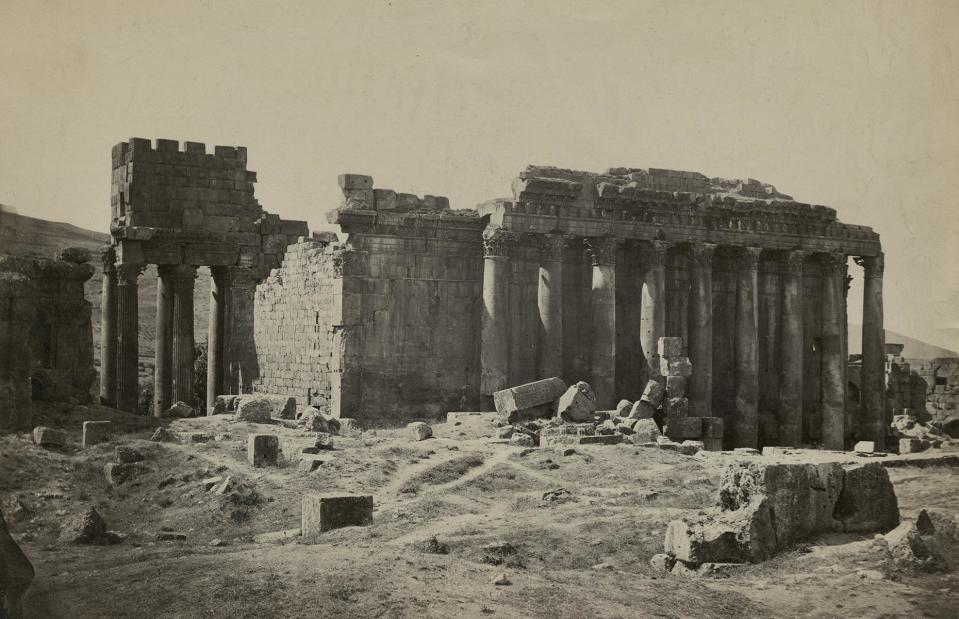
Spencer Arnold Collection/Hulton Archive/Getty Images
From one breathtaking remnant of the Roman Empire to another: the Temple of Bacchus is a key site at Baalbek, a ruined Roman town in Lebanon's Beqaa Valley. The temple itself is made up of intricate Corinthian columns and was dedicated to Roman gods of agriculture and fruitfulness. It's pictured here circa 1880, surrounded by rubble, its impressive columns crumbling.
Temple of Bacchus, Baalbek, Lebanon
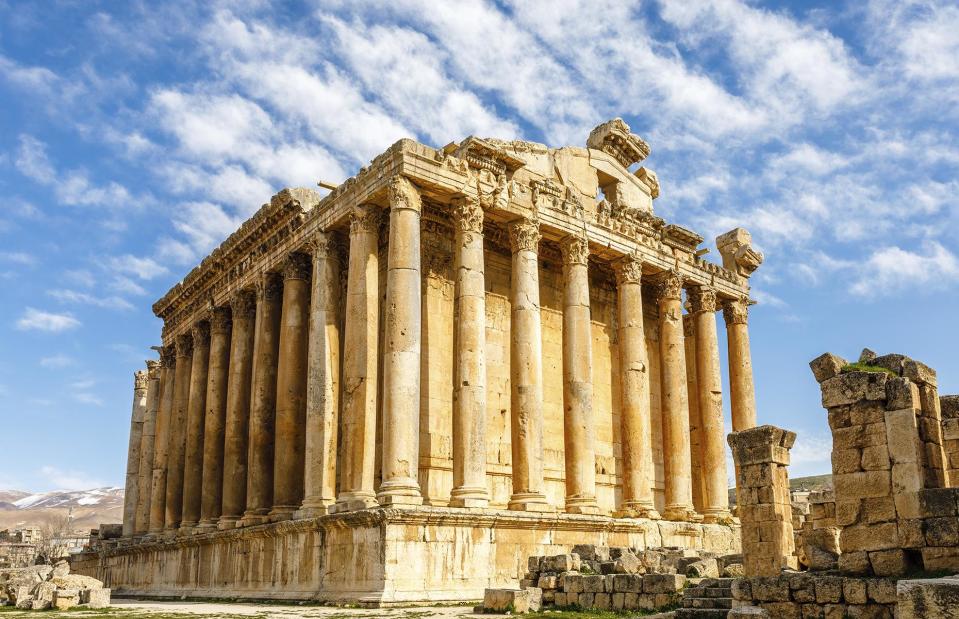
Vadim Nefedoff/Shutterstock
Excavations and restoration projects began at the site in the late 19th century and into the 20th century, and Baalbek's ancient structures underwent repairs over time. This recent shot shows the Temple of Bacchus looking remarkably more pristine than it did in the 1880s. It also came under UNESCO's protection in 1984.
Take a look at the sites on UNESCO's World Heritage in Danger List
Pyramid of the Sun, Teotihuacán, Mexico
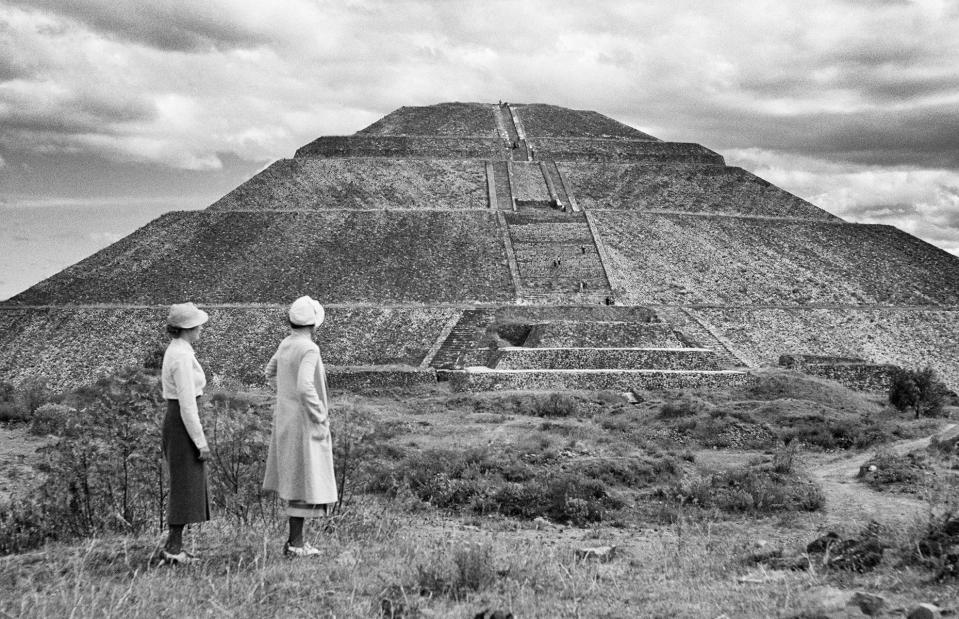
H. Armstrong Roberts/ClassicStock/Getty Images
Some 30 miles (48km) northeast of Mexico City lies the ancient city of Teotihuacán and its series of monumental, pre-Hispanic landmarks. Dominating them all is the Pyramid of the Sun, which soars to an eye-watering 216 feet (66m) and is thought to date back to around AD 100. It dwarfs this pair of tourists, who gaze up at the pyramid in the 1930s.
Pyramid of the Sun, Teotihuacán, Mexico
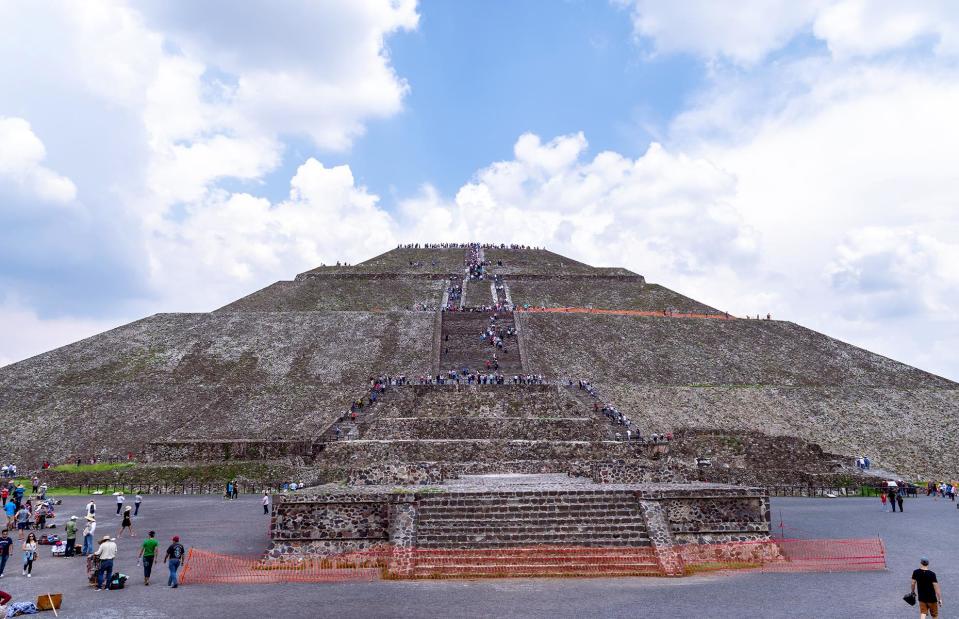
Ivan.M.F.81/Shutterstock
Just under a century later, travelers are still flocking to this fascinating Mexican site. This modern photo shows tourists gathering at the foot of the towering structure and also climbing the steps that lead up to its summit. The entire site is ripe for archaeological discoveries too. Secret tunnels and a chamber were found under its sister landmark, the Pyramid of the Moon, in the last decade.
Chichén Itzá, Mexico
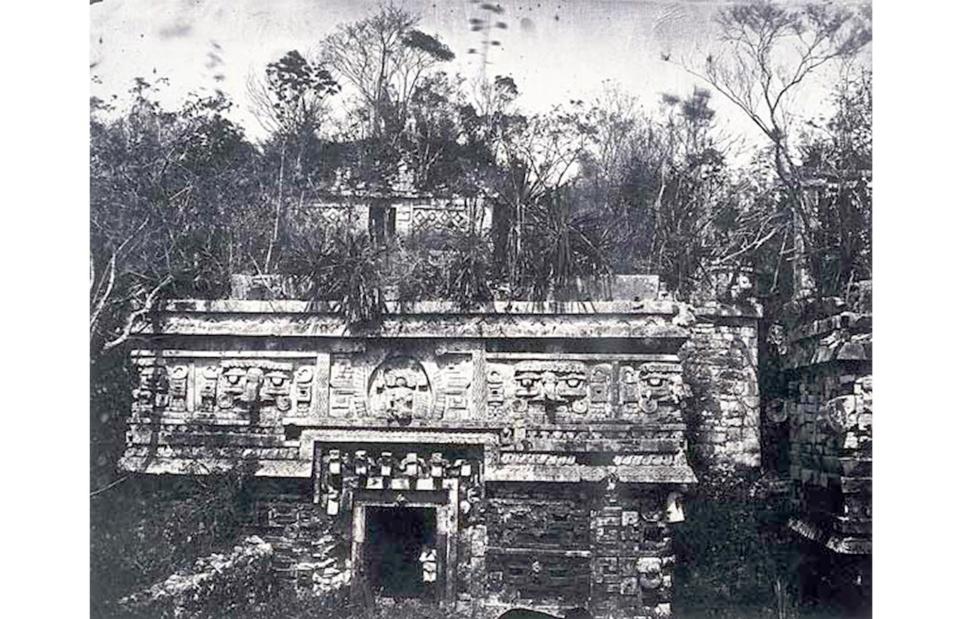
Désiré Charnay/Wikimedia Commons/CC0
You might be familiar with images of Chichén Itzá – an ancient Maya city known for landmarks like the grand, stepped pyramid of El Castillo. But this photograph, taken circa 1859–1860, shows the famous archaeological site in a rather different state. The city was once home to tens of thousands of people, flourishing around AD 600, when it was a political and commercial heartland of Maya civilization. Yet it began to decline before the Spanish conquest. It's pictured here ruined and covered with vegetation in the mid-19th century.
Chichén Itzá, Mexico
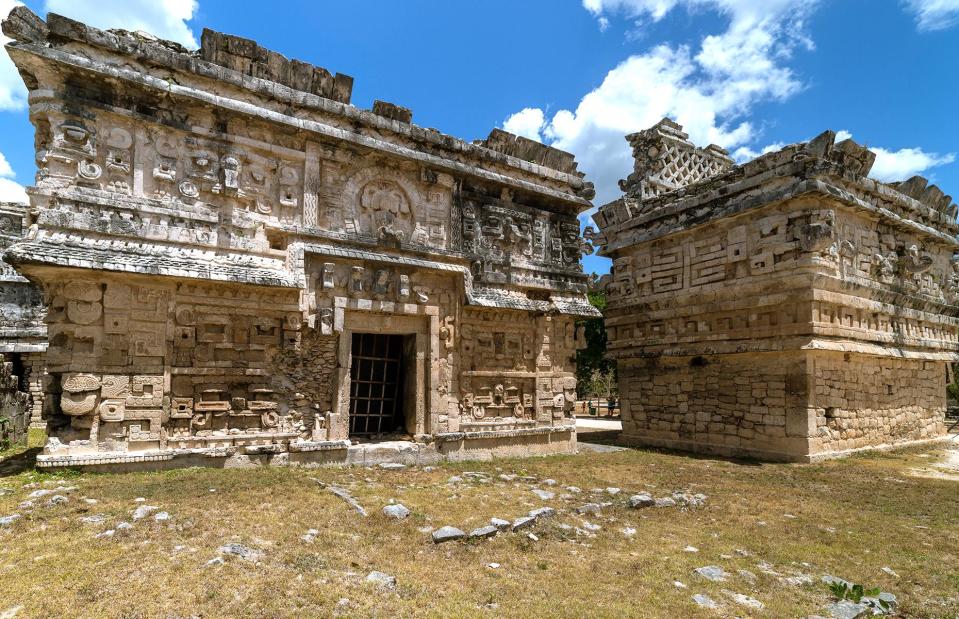
Walkabout Photo Guides/Shutterstock
Through the early 20th century, extensive work was carried out at the site: vegetation was cleared, ancient relics were excavated and striking monuments were restored. This photo shows a section of the site in the modern day, no longer swallowed by trees and shrubs. Exciting new developments are occurring here too. Come 2022, Chichén Viejo, a new jungle-clad fragment of the site, will open to the public. Unlike in the past, though, the vegetation won't be cleared. Modern archaeologists have realized that the overgrowth acts like a protective "skin" for the ruins and should be left as is.
Mortuary Temple of Hatshepsut, Egypt
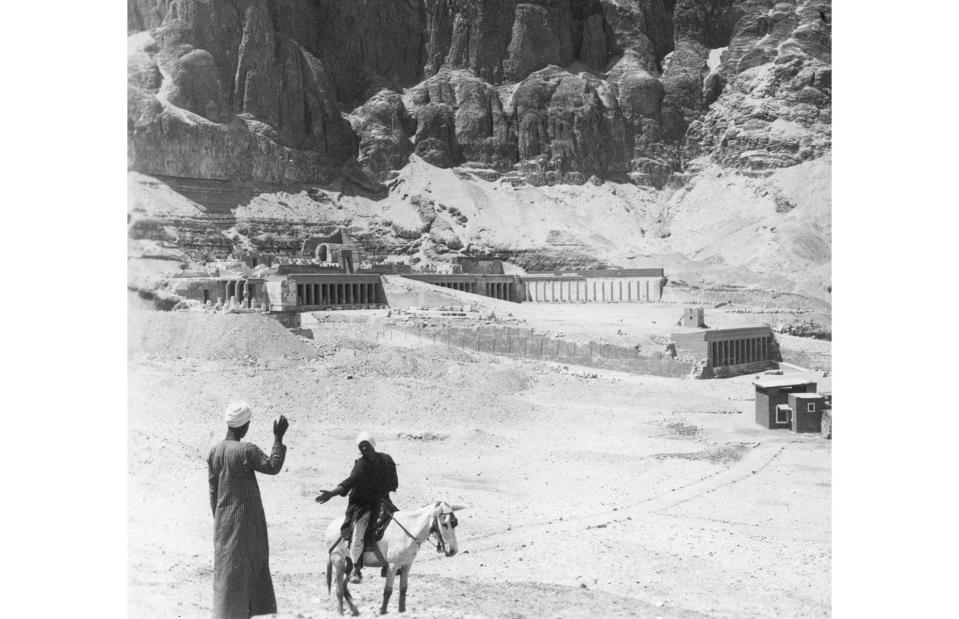
The Print Collector/Print Collector/Getty Images
The Great Sphinx and pyramids of Giza are Egypt's most famous ancient wonders – but the Mortuary Temple of Hatshepsut, located at the Dayr al-Baḥrī archaeological site, is rather special too. It's thought to have been built in the 15th century BC for Queen Hatchepsut, who reigned from around 1473–58 BC. The ruined temple is pictured here sometime around the turn of the 20th century.
Mortuary Temple of Hatshepsut, Egypt
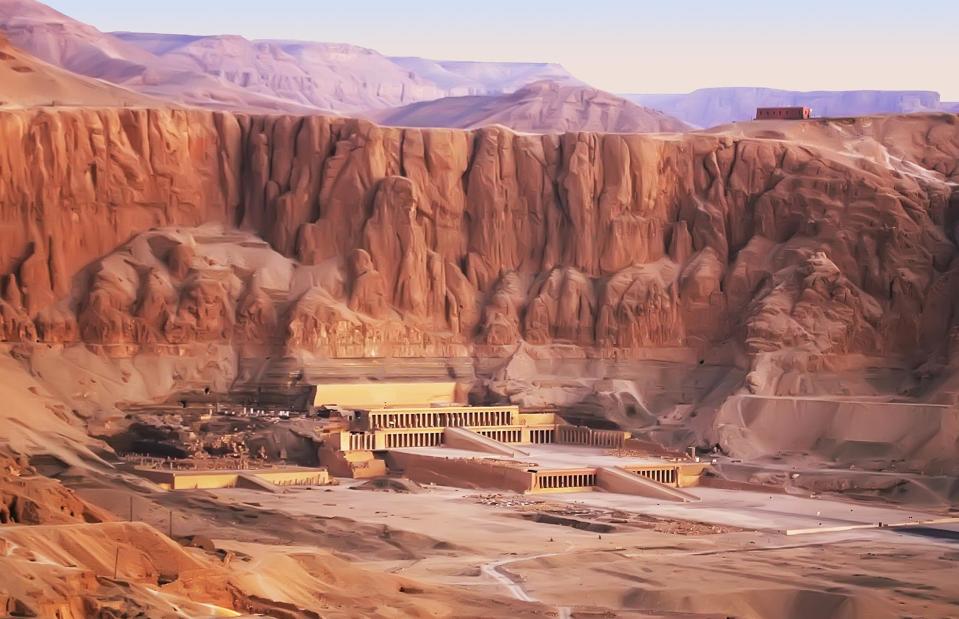
Eric Valenne geostory/Shutterstock
The temple's sleek platforms and pillars look markedly more intact and pristine in this modern shot than they did in the early 20th century. The site underwent major excavations and reconstruction work from the 1960s onwards and the results were magnificent. Statues have also been excavated, and modern-day tourists can explore the complex and learn about the fascinating life of this female pharaoh.
Check out more beautiful treasures the ancient Egyptians left us
Terracotta Army, Xi'an, China
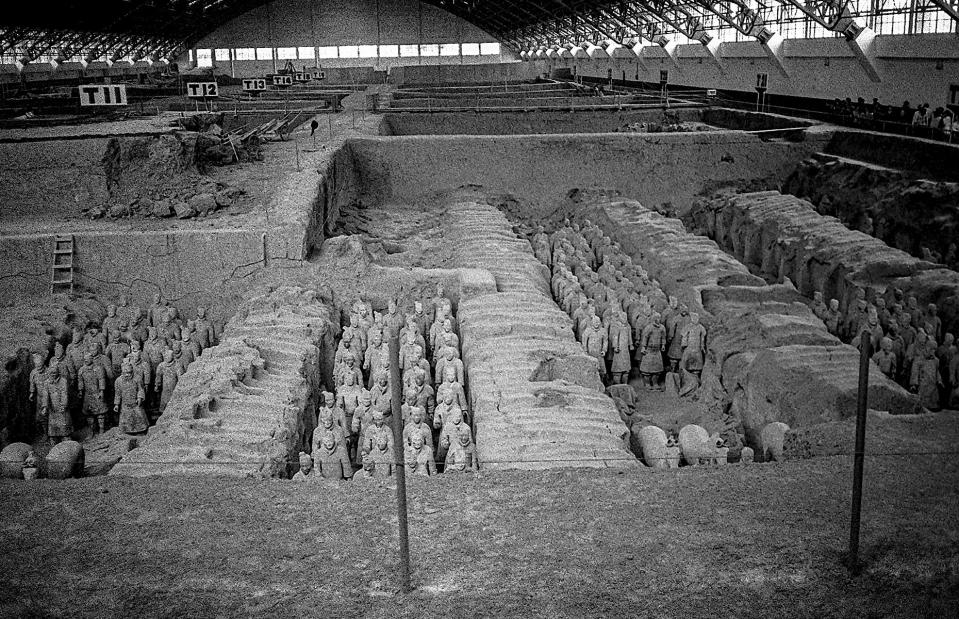
Howard Ruffner/Getty Images
It's almost impossible to believe that this incredible wonder was discovered in such recent history. In 1974, workers were digging a well in China's Shaanxi Province when they uncovered something amazing: a single clay soldier. When experts descended on the site they found it was part of an entire, thousands-strong army made up of terracotta figures in trench-like pits. Archaeologists continued excavations in the decades that followed and their ongoing efforts are pictured here circa 1986.
Terracotta Army, Xi'an, China
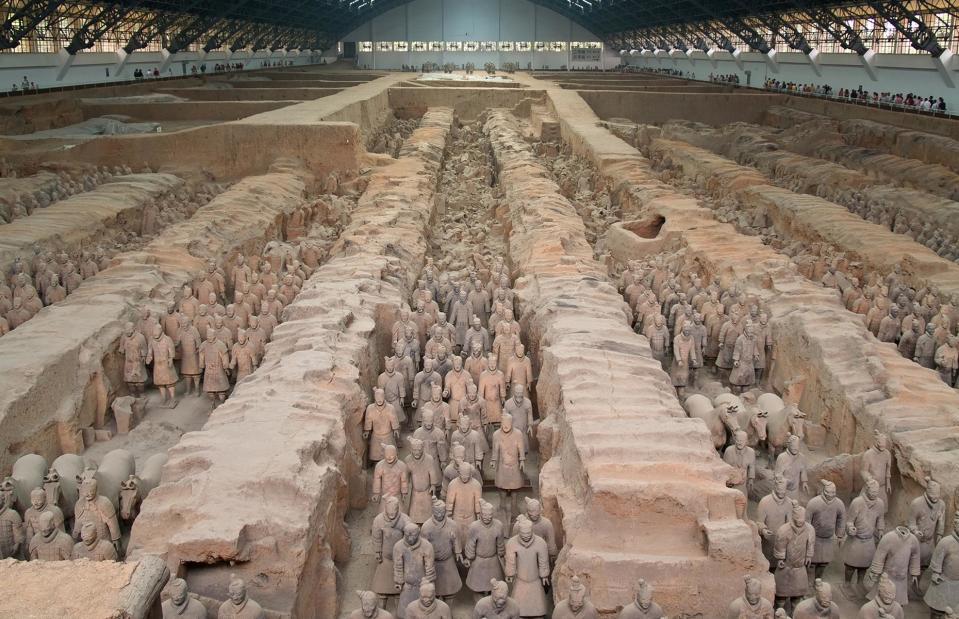
Jarno Gonzalez Zarraonandia/Shutterstock
The figures, buried close to the mausoleum of Qin Shi Huang (founder of the Qin dynasty), are thought to date to the 3rd century BC and were likely created to protect the late emperor in the afterlife. This current-day photograph shows the site after further excavations, which revealed even more terracotta effigies. Work at the site is ongoing with archaeologists suspecting that yet more soldier-filled pits will be uncovered.
Ephesus, Turkey
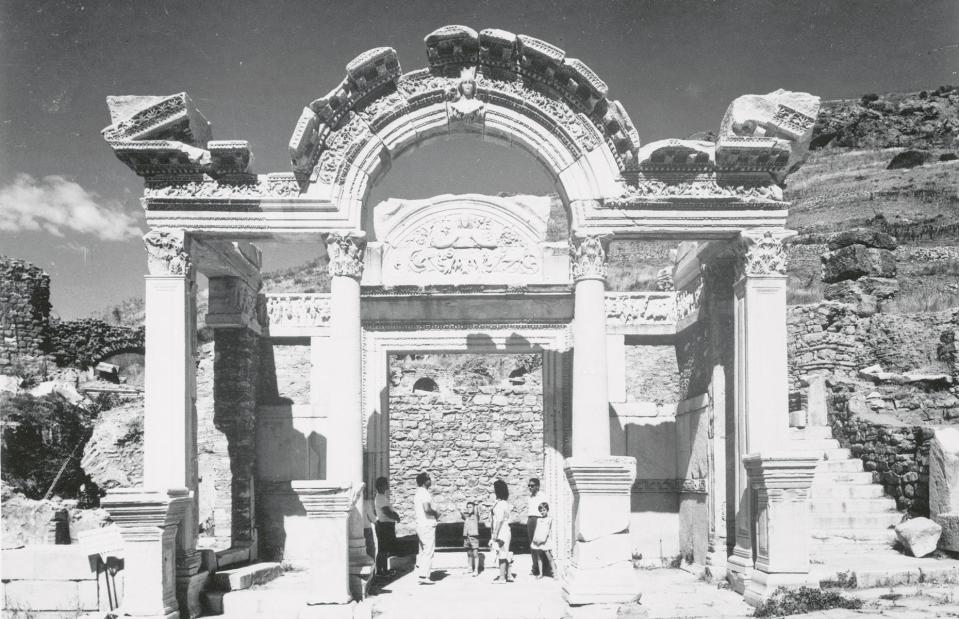
Bettmann/Getty Images
One of Turkey's most famous ancient sites, Ephesus is an ancient Greco-Roman city once home to some 250,000 people. Among the relics are the Temple of Hadrian, thought to date to the 2nd century AD, comprising a grand arch and detailed reliefs. The wonder has been drawing history buffs for decades too. Here a family admire the ancient marvel sometime in the 1960s.
Ephesus, Turkey
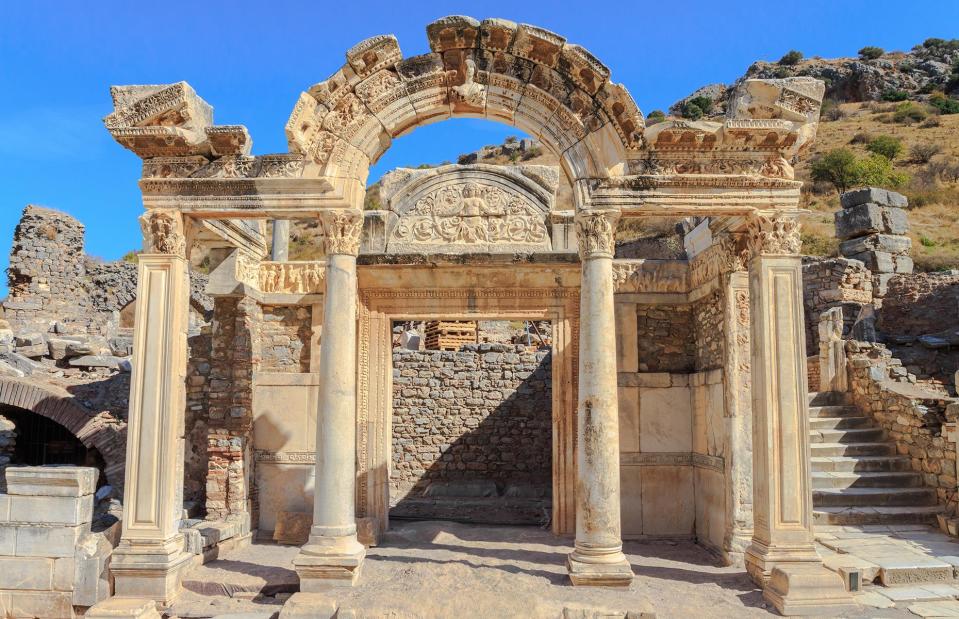
takepicsforfun/Shutterstock
Barely a thing has changed in this photo from the modern day. The elegant monument still stands sentry at the ancient site, drawing tourists beneath its archway. And there may still be more treasures to come. It's thought that vast tracts of this millennia-old city are still yet to be excavated.
Pompeii, Italy
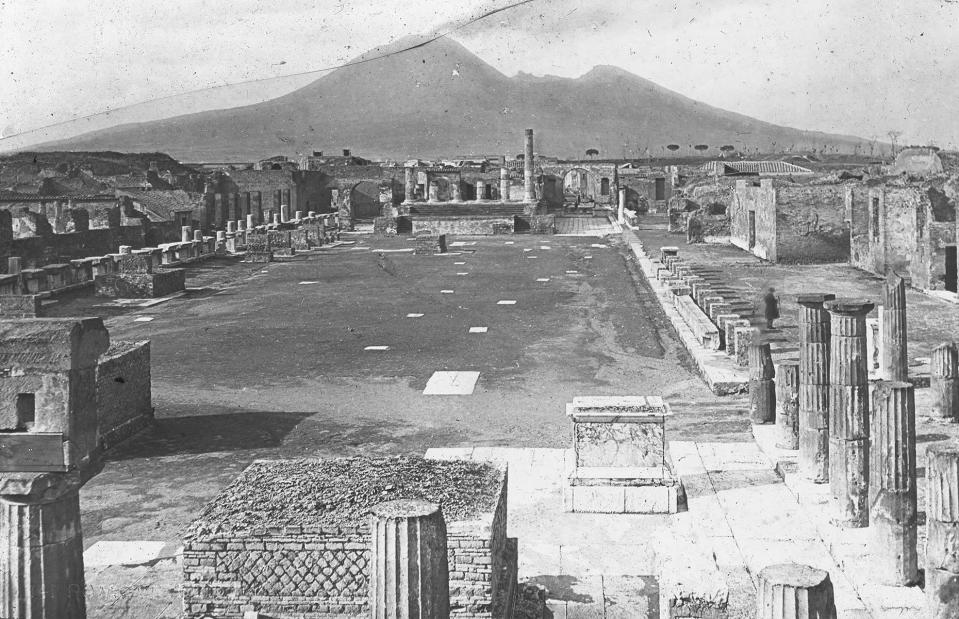
The Print Collector/Print Collector/Getty Images
Probably the world's most famous ruined city, Pompeii was swallowed by lava and ash when Mount Vesuvius erupted in AD 79. Before it met its tragic fate, the city was a booming center of trade and a cultural hub, with buildings such as bathhouses, temples, an amphitheater and more. When Pompeii's ruins were finally uncovered in the 16th century, they were impressively preserved due to the layer of ash that had shrouded them for millennia. They're shown here in the early 20th century.
Pompeii, Italy
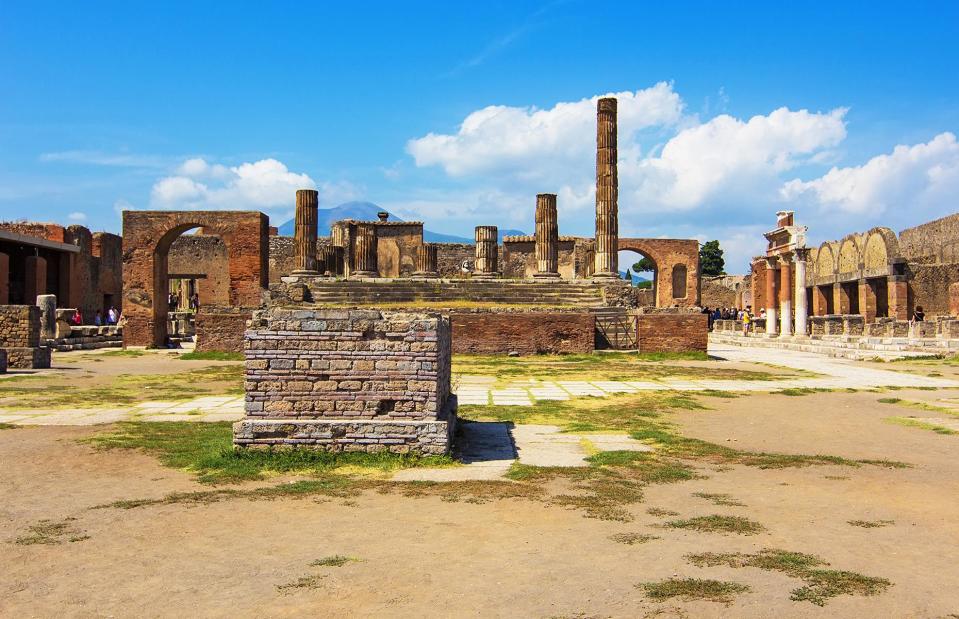
The Print Collector/Print Collector/Getty Images
A similar view of Pompeii's Forum is captured here in the present day. Still the ruins are painstakingly preserved and you can spot tourists milling about the ancient remnants. Archaeological work continues to uncover more about Pompeii's residents too. From ongoing excavations, experts have been able to reveal everything from their political ideals to their lunch choices...
Take a look at more amazing lost cities rediscovered
Tikal, Guatemala
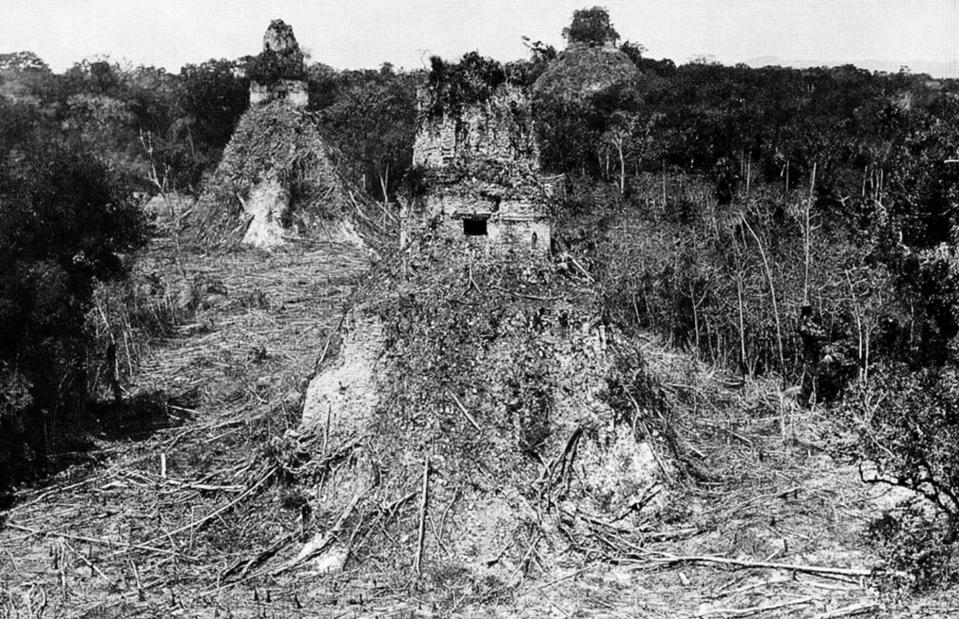
Alfred Percival Maudslay/Wikimedia Commons/CC0
Another ancient site once veiled by greenery, Tikal, in northern Guatemala, was an ancient Maya city and a ceremonial hub. It bloomed from about 300 BC and was eventually populated with great plazas and pyramids, many of which have been preserved for posterity. This is an early photograph of the site, snapped around 1882. The breathtaking ruins are choked by vegetation and the floor is littered with trees. The photo was taken by British explorer Alfred Maudslay, who was involved in mapping and excavating the site during the 1880s.
Tikal, Guatemala
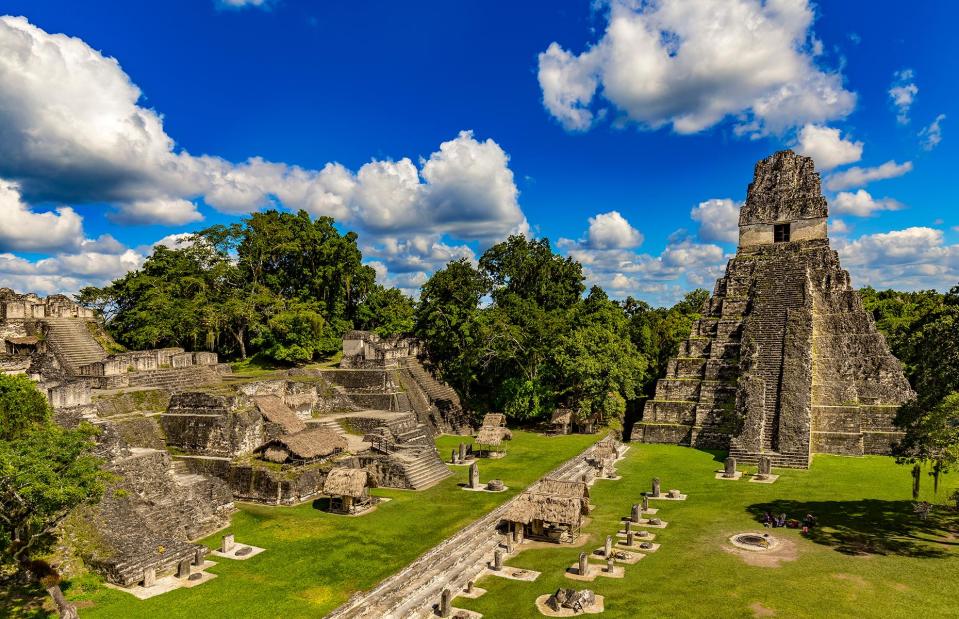
WitR/Shutterstock
Now the ruins, part of Tikal National Park, usually draw tourists from all over the globe and a museum, opened in the 1960s, sheds further light on the ancient settlement. Best of all, it seems that there's much more of this fascinating site to discover. In fact, studies using LiDAR technology have suggested that Tikal is four times larger than experts originally thought.
Cliff Palace, Mesa Verde National Park, USA
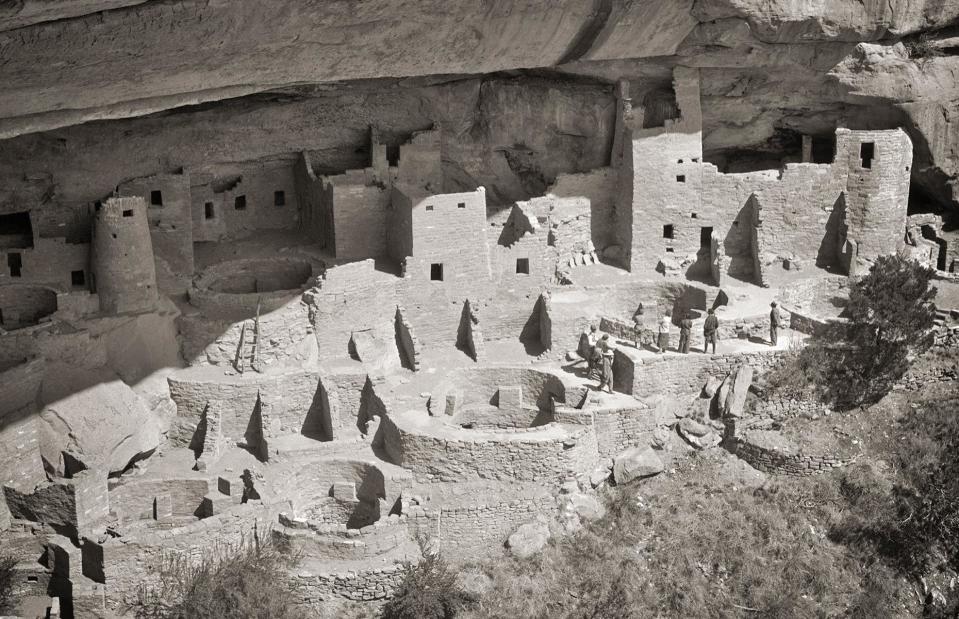
H. Armstrong Roberts/ClassicStock/Getty Images
America's ancient landmarks are often forgotten, but sites across the States offer intriguing insights into the country's earliest settlers. Among them is Mesa Verde National Park and its Cliff Palace, an incredible 150-room dwelling built up by Ancestral Pueblo people from around AD 1190 to 1260. It's pictured here in the 1930s, and you can see tourists wandering about the walls and kivas.
Cliff Palace, Mesa Verde National Park, USA
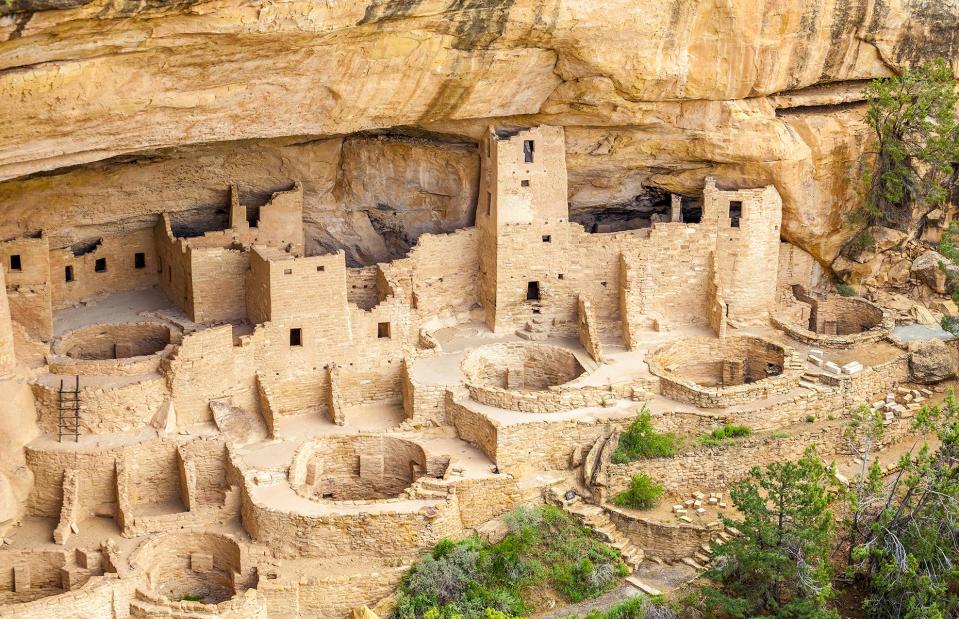
Sopotnicki/Shutterstock
Little has changed over the past decades and this could be the same image, just in vibrant color. It's typically possible to explore the Cliff Palace on a ranger-led tour, peeking into ancient rooms and climbing steep ladders. In 2021, the park was also certified as an International Dark Sky Park – the 100th such site in the world.
Discover more of America's incredible ancient ruins
Parthenon, Athens, Greece
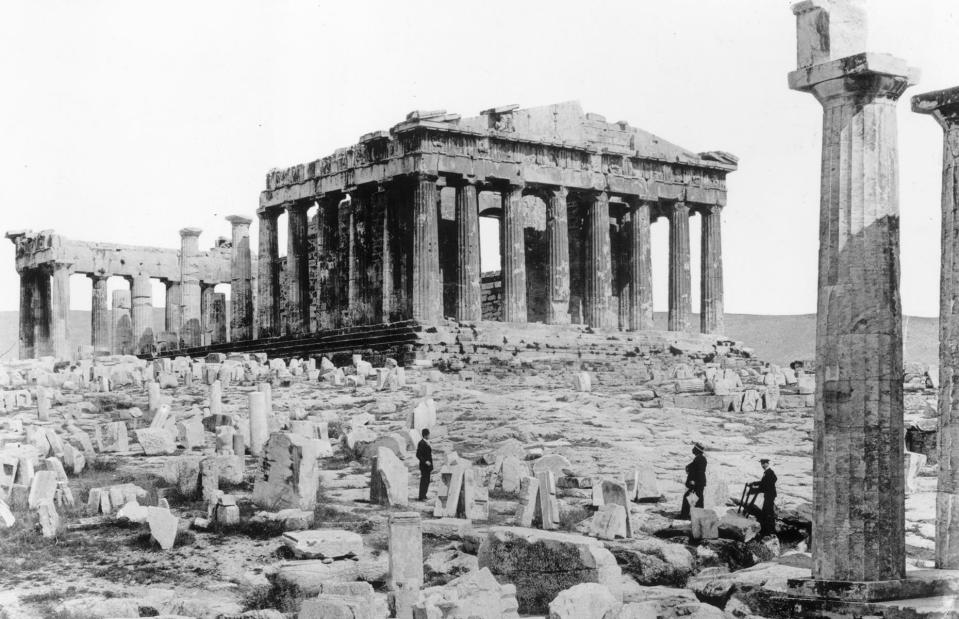
Henry Guttmann Collection/Hulton Archive/Getty Images
The Acropolis watches over Greece's capital city and the Parthenon, a striking ruined temple devoted to the goddess Athena, is its glittering crown jewel. A jaw-dropping marble confection with Doric columns, ornate sculptures and friezes, and a tiled roof, it was built in the 5th century BC under statesman Pericles. Centuries later, circa 1910, the tourists in this photo gaze upon the Parthenon's mighty shell.
Parthenon, Athens, Greece

anyaivanova/Shutterstock
Taken from a slightly closer angle more than 100 years later, this photograph shows that the Parthenon has changed little over the last century. The columns remain, as does the ruined portico, both rising up amid scattered boulders. Now fragments of the ancient Greek temple are housed (sometimes controversially) in museums around the world, from Paris to Vienna. Among the most impressive are the Elgin Marbles, a series of intricate friezes and sculptures at the British Museum.
Colosseum, Rome, Italy
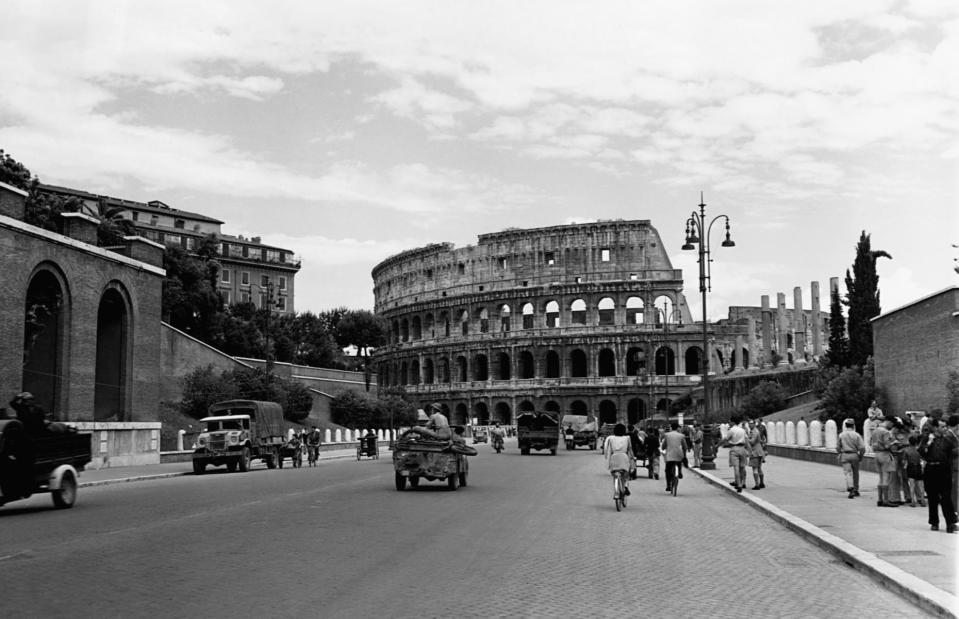
CORBIS/Corbis/Getty Images
Millennia have passed but Rome's iconic amphitheater, built around AD 70–72 for Flavian emperor Vespasian, still looms in the city center. It was once the setting for gruesome gladiatorial battles and animal shows watched by some 50,000 people at a time. Yet it's an empty shell in this photo from 1944. Spot the vintage cars and the army vehicles – the Second World War would rage on for another year after this image was captured.
Colosseum, Rome, Italy

Viacheslav Lopatin/Shutterstock
Fast-forward to the modern day and the ancient wonder is a bustling tourist hub: once-quiet roads hum with traffic and tourists can be seen peering out from its bold archways. Despite the landmark's age, we're still discovering its secrets. Tiny details like little red numbers painted above those archways offer hints about its history: in this instance, the numbers suggest that Roman spectators followed an ordered seating plan. A new, retractable floor is also set to be installed at the Colosseum, allowing tourists to stand right where gladiators once clashed.
Now take a look at the world's most stunning ancient ruined cities
Great Wall of China, China
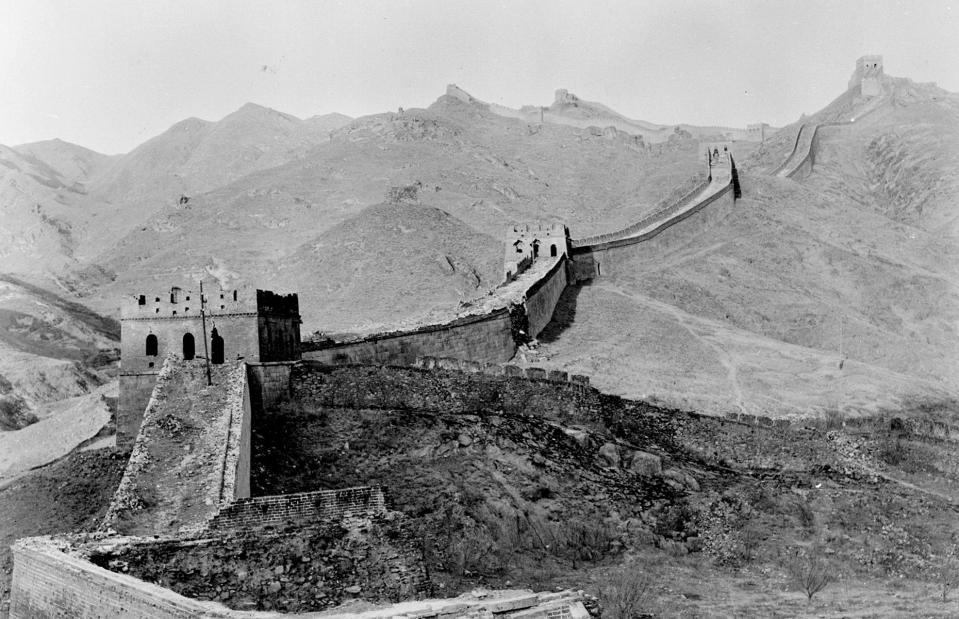
Three Lions/Getty Images
The scale of China's Great Wall is immense: it wriggles out for around 13,171 miles (21,197km) according to the most recent estimates and is punctured by hulking watch towers. While the wall's roots go as far back as the 7th century BC, the best-preserved sections (one of which is pictured here) date to the Ming Dynasty (from the 14th to the 17th centuries). The most touristed segment, at Badaling, was also restored in the 1950s, the same decade that this photo was captured.
Great Wall of China, China
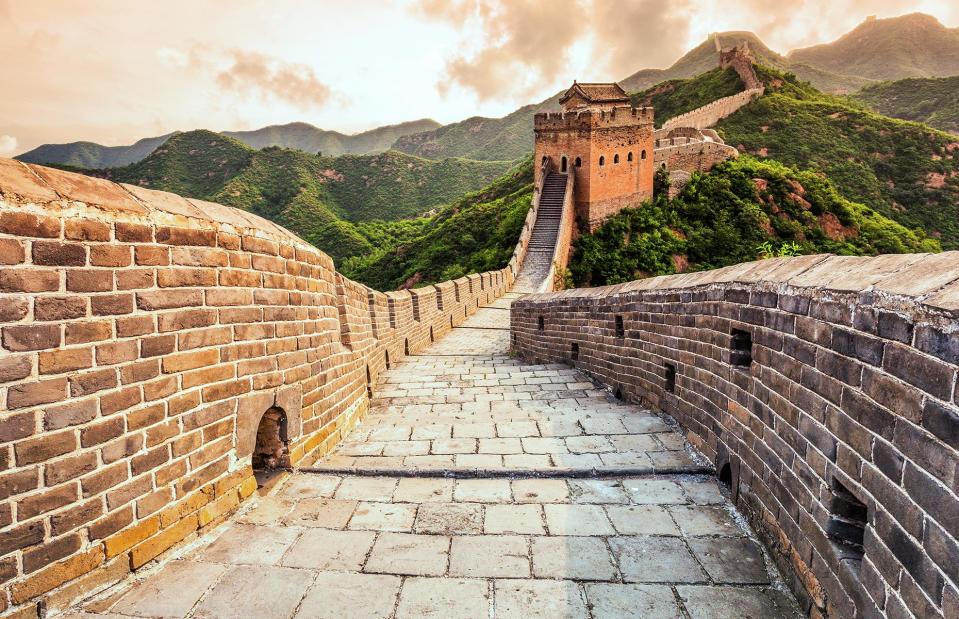
zhu difeng/Shutterstock
Fast-forward almost three quarters of a century and the wall typically attracts millions of visitors each year. In recent years, the wall's 'wildest' parts have been given some attention too. The Jiankou section is one of the structure's most famously remote and perilous fragments, spilling over soaring mountains in a spool of rubble and ruin. However, high-tech renovation efforts occurred in 2019 and beyond, in an effort to make the area safer for visitors and to preserve it for posterity.
Now take a look at these ancient places you'll never get to visit


